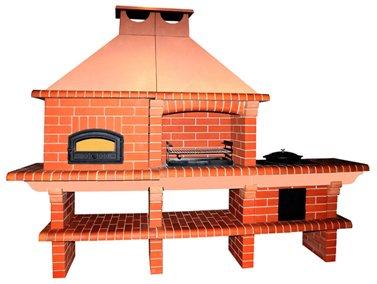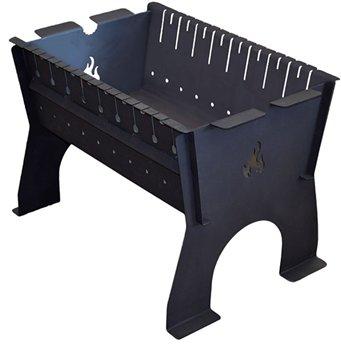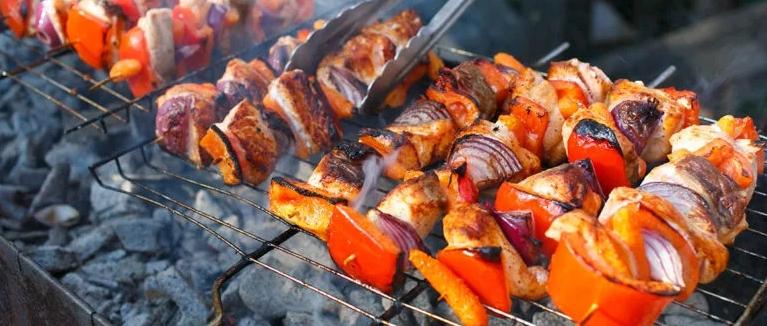There is no ideal barbecue that can suit any person, since everyone has their own preferences in appearance, shape and material. Despite this, there are several design characteristics that are important for any type, so you should know how to choose a brazier. For example, you can buy an expensive barbecue made of forged parts and other additions, but making a high-quality barbecue in such a design will not work, since manufacturers do not always take into account certain features. So that the acquisition is not a simple decoration, you should read the article material.
Content
The design and principle of operation of the barbecue
Classic barbecues, which are often used to make barbecue, are structurally very simple:
- The base is in the form of legs with a height of 15-80 cm.
- The brazier is made in the shape of a rectangle. The walls at the top can be with or without skewers.
Cooking meat or other foods is done using the heat from the coals. The essence of such a product is to keep the temperature of coals in a heap.
When choosing, it is important to focus on the design. Mobile models are great for fishing, picnics, outdoor recreation, as well as using the barbecue for trips to the country. Goods are often small in weight and size, which makes transportation easier. Models made of stainless steel have proven themselves best. When choosing, you should be aware that mobile versions can be folding or collapsible. The former are characterized by fastened parts that need to be folded and unfolded correctly, the latter are made from the same parts, but they are all removable. The main disadvantage of collapsible devices is that it will be difficult or impossible to insert elements during deformation. All portable barbecues with thin walls, which reduces the service life and affects heat loss.
Stationary devices are suitable for home and barbecue installation on the site. Often they are placed in a garden, gazebo or resting place. They are of great weight, size, and can be made of any material.
Brazier types
You can determine how to choose a barbecue for a summer residence in order to pamper yourself with meat, fish or vegetables on a fire if you deal with the possible types of braziers.
Brick grill

Such models of the barbecue are completely stationary, made in a separate place near the house. For the construction it will take a lot of effort, time and money, in addition, the foundation will need to be poured under the structure.
Pros:
- Long-term heat retention.
- Often, models include a chimney, which makes it possible to prepare meals with increased comfort.
- The structure can be used at any time of the year, regardless of the weather, since it is closed.
- Can be a part of decoration for a private house.
Minuses:
- High cost and complexity of construction.
- It takes time to build such a barbecue.
- After firing up, there will be heat transfer to the brick, and only then to the dish, but the process can be accelerated if a steel sheet is laid on the bottom of the brazier.
Cast iron grill

Cast iron brazier is characterized by durability.Many companies offer ready-made stationary models and collapsible versions, from which the walls can be easily removed and the entire brazier can be transported outdoors or on a trip. In addition to the grill, there may be a grill for cooking vegetables, steaks or cooking in dishes.
Pros:
- Reliability - structural elements do not deform under the influence of heat;
- Durability - a high-quality cast-iron grill will last at least a century, it can be passed on from generation to generation;
- Resistance to corrosion - in comparison with steel braziers, cast iron is subject to corrosion processes to a lesser extent;
- Economical - the material heats up quickly and perfectly retains heat thanks to its thick walls, which reduces the consumption of firewood and coal;
- Saving time - you can cook vegetables or meat faster than in a steel grill;
- Aesthetics - cast iron decorative elements can be made in any style: original national, classical, modern. Such a brazier will serve as a decoration of the personal plot.
Minuses:
- High pricing policy.
- A large mass that becomes critical for mobile, portable models. This parameter will not be important for a stationary frypot.
- As a result of sudden temperature changes, some parts of the barbecue may crack. If you plan to fry in winter or autumn, when it is cold outside, then there are risks of cracking as a result of rapid ignition. In this case, it is better to do a gradual heating.
Brazier made of steel

Steel models can be portable and stationary. These braziers differ in wall thickness, so the quality will vary. If the walls are small, then the product will be light and convenient for transportation, and with an increase in the indicator, the service life of the model increases.
Some devices are made of stainless steel, which gives additional protection against corrosion. It is this type that has become better used for portable structures that are operated in nature.
Steel barbecues are often decorated with forging, which is located directly on the walls and allows you to increase the thickness and service life. In addition, decorative elements can slightly increase the heat transfer characteristics of the steel.
Pros:
- Acceptable cost.
- Relatively small mass.
- A large assortment that will help you choose a barbecue for the country, nature or for other needs.
Minuses:
- Mobile braziers are often made of very thin steel, which does not allow the use of firewood, as metal deformation will occur.
- A brazier made of material less than 3 mm, with constant use, is subject to burnout for several seasons.
How much do barbecues cost
The price of the brazier will directly depend on the dimensions, as well as materials, workmanship and additional elements in the device. On average, the cost for simple structures will be as follows:
- Cast iron options will cost between 7-70 thousand rubles.
- Mobile barbecues for a hike made of thin steel cost only 300-1500 rubles.
- Portable models for a summer residence or a private house within the range of 1500-4000 rubles.
- Stationary devices with walls up to 1.8 mm will be in the range of 2-5 thousand rubles, and if the metal is more than 3 mm, then the price rises to 7-20 thousand rubles.
Such devices for cooking barbecue or other dishes on fire can hardly be called a luxury, but manufacturers are not ready to give goods for a pittance. When choosing, it is important to take into account the useful volume, as well as other equally important characteristics, which will be discussed below.
Brazier selection parameters
Dealing with the question of how to choose the right brazier will work out if you know the main parameters and design characteristics of the device. With the help of this information, you can buy the best option that will last a long time.
Barbecue depth
This characteristic will help determine the volume of charcoal and affect the taste of the dish. The optimal size for a barbecue is considered to be 15-20 cm, which gives the desired distance between meat and heat.This arrangement allows you to make meat or fish very juicy, and everything will be fried evenly, a light crust will appear that does not burn.
In the case of choosing a shallow model, the product will be close to the source of heat, so burning from the top will begin and there will be no roasting inside. Very deep roasting pans require a lot of charcoal to be added in order to achieve an optimal gap between meat and heat. Otherwise, the quality and taste of the dish will be spoiled.
Among the main disadvantages of using a brazier with a depth of more than 20 cm are:
- Increased consumption of wood or coal.
- Long cooking time for barbecue.
- There is no crust on the meat, and during the cooking process the juice will flow out, so the kebab will be dry.
Width and length
When choosing the width, you need to be guided by the size of the skewer, the value should be slightly less, often 30-40 cm. The length of the brazier is selected based on the number of skewers and the number of people. For example, for 4-5 people, a brazier that can accommodate 8 skewers will be enough. They should be placed with a distance of about 8 cm from each other.
This leads to the fact that the length of the barbecue is 65-80 cm. Many manufacturers immediately make grooves on the walls for skewers, which makes it possible to determine their number. For people who often meet guests and host large companies, you should choose models for a large number of skewers, respectively, the length will increase.
Metal thickness
The durability of the brazier will depend on the thickness of the steel. Thin metal models are popular among users due to their low cost, but such devices quickly burn out, especially with frequent use. The main advantage is mobility and low weight.
In order for the brazier to serve for a long time, not to change its shape from temperature exposure, one should focus on a thickness of 3 mm or more. In this case, the rule works, the thicker the metal, the better, but everything is within reason.
Double bottom
The presence of a double bottom gives a number of advantages in comparison with conventional models:
- The time for ignition is reduced.
- A layer of air appears between the bottoms, which helps to make high-quality thermal insulation, and this leads to uniform burning of coal. This factor allows you to save on firewood.
- The ash is collected in a separate pan.
- It is possible to control coal not only with a fan, but also through dampers or a container for collecting ash.
Often, manufacturers put a grate on the bottom of the barbecue, which allows you to hold pieces of coal, and ash is removed through separate holes. Such grids are solid and type-setting, their essence is to support fire and improve oxygen access. Some models are sold without grates, and special holes are made on the top bottom to help air pass and ash crumble.
Blow-out holes
Many of the barbecues that are on sale are made with holes in the bottom or on the sides. But experts in the preparation of barbecue are sure that this is done for lazy people, since the temperature of the heat inside must be controlled by the cook himself, using a fan.
Holes in the side parts do not make it possible to monitor the smoldering of coals, and in case of wind, a fire starts. Such holes may not in the best way affect the quality of the dish, since the heat closer to the side edges turns out to be stronger than in the center, which means that the meat will be worse and unevenly fried.
Despite this, when choosing, you should not give up the holes if they are at the top of the barbecue. They do not affect the quality of the product and are more decorative.
When choosing a barbecue with 1 bottom and without the presence of blow-through holes, the user gets several advantages:
- The heat inside will be even, which improves the quality of the kebab or other products.
- The coals are under the complete control of the cook.
- There will be no risk of burns in case of hot coal falling out of the holes on the leg or arm.
- The kebab can be left unattended for a few minutes, which causes only a slight decrease in the temperature of the heat, but with the help of the fan everything will resume without fires.
It is recommended to select air vents only in barbecues where 2 bottoms are used.
Cap
A brazier with a lid allows you to cook the dish faster, in addition, it is more saturated with smoke, adding flavor. With this add-on, the user gets additional features:
- Smoking meat and fish.
- Cooking food that needs a little heat.
- Keeping the finished product warm.
If the barbecue model is complex, then the lid can be supplemented with a thermometer, as well as dampers that help remove or add traction.
Folding shelf
With such an addition, comfort and ease of use will increase. It is recommended to pay attention to the shelf for those who are not always near the barbecue and need to save the dish from the sharp ignition of the coals. In addition, the shelf acts as a cover while the structure is not in use.
How to choose a brazier
Even after studying all the features, some people cannot choose the right brazier for themselves, so experts have made several simplifying tips:
- For permanent use of inventory, it is recommended to use options made of steel or cast iron with a wall thickness of 3 mm or more. In case of stopping selection on steel devices, it is best to choose a double bottom.
- People who plan to often use the grill outdoors and take it on a trip should use collapsible structures. For charcoal operation, the optimal wall thickness will be 1 mm. With constant use, such a product will be able to work for about a couple of seasons.
- In the case of complementing the appearance of the site near the house or a gazebo, furniture, then you can give preference to a brazier with forged elements.
- For the garden, it is convenient to use the option with a small canopy, which will exclude rain from entering while cooking on fire.
- The addition of wheels simplifies operation, especially if the brazier is used intermittently and must be constantly removed from the garage or shed.
Having studied how to choose a barbecue for a barbecue, you can buy the optimal type in shape, size and other indicators that are important for a particular person.



